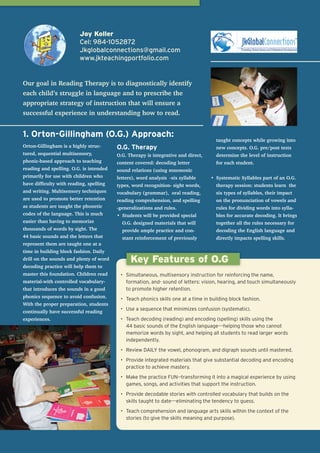
Leaflet[1]
- 1. Joy Koller Cel: 984-1052872 Jkglobalconnections@gmail.com www.jkteachingportfolio.com Our goal in Reading Therapy is to diagnostically identify each child’s struggle in language and to prescribe the appropriate strategy of instruction that will ensure a successful experience in understanding how to read. 1. Orton-Gillingham (O.G.) Approach: taught concepts while growing into Orton-Gillingham is a highly struc- O.G. Therapy new concepts. O.G. pre/post tests tured, sequential multisensory, O.G. Therapy is integrative and direct, determine the level of instruction phonic-based approach to teaching content covered: decoding letter for each student. reading and spelling. O.G. is intended sound relations (using mnemonic primarily for use with children who letters), word analysis -six syllable • Systematic Syllables part of an O.G. have difficulty with reading, spelling types, word recognition- sight words, therapy session: students learn the and writing. Multisensory techniques vocabulary (grammar), oral reading, six types of syllables, their impact are used to promote better retention reading comprehension, and spelling on the pronunciation of vowels and as students are taught the phonetic -generalizations and rules. rules for dividing words into sylla- codes of the language. This is much • Students will be provided special bles for accurate decoding. It brings easier than having to memorize O.G. designed materials that will together all the rules necessary for thousands of words by sight. The provide ample practice and con- decoding the English language and 44 basic sounds and the letters that stant reinforcement of previously directly impacts spelling skills. represent them are taught one at a time in building block fashion. Daily drill on the sounds and plenty of word Key Features of O.G decoding practice will help them to master this foundation. Children read • Simultaneous, multisensory instruction for reinforcing the name, material-with controlled vocabulary- formation, and- sound of letters: vision, hearing, and touch simultaneously that introduces the sounds in a good to promote higher retention. phonics sequence to avoid confusion. • Teach phonics skills one at a time in building block fashion. With the proper preparation, students • Use a sequence that minimizes confusion (systematic). continually have successful reading experiences. • Teach decoding (reading) and encoding (spelling) skills using the 44 basic sounds of the English language---helping those who cannot memorize words by sight, and helping all students to read larger words independently. • Review DAILY the vowel, phonogram, and digraph sounds until mastered. • Provide integrated materials that give substantial decoding and encoding practice to achieve mastery. • Make the practice FUN--transforming it into a magical experience by using games, songs, and activities that support the instruction. • Provide decodable stories with controlled vocabulary that builds on the skills taught to date---eliminating the tendency to guess. • Teach comprehension and language arts skills within the context of the stories (to give the skills meaning and purpose).
- 2. 2. MIM-Many Interesting Meanings metacognative environment encour- ages awareness of thinking. Our Key Features of MIM Class: Metacognitve strategies like MIM MIM tricks are quick, humorous and activities like the Word Web mnemonics that teach key help students’ make connections and strategies about words. reflect upon their own learning about the “web of words” in their heads. Word Web, a chart that We begin with the children’s prior provides a simple, visual way of knowledge about a word’s meaning illustrating how words are by developing explicit elaboration and depth around “known” words. We Interconnected to improve can never assume a child knows the comprehension and vocabulary meaning of a word, much less the fact skills it might mean several different things. We need to know what they know and build from that base. Our fun strat- does not “see” a picture of the word egy provides a visual mnemonic for he/she is reading, they will have dif- children to store multiple meanings of ficulty comprehending the meaning words from the start. We explore the of the word. Discussion encourages multiple meanings of “core” words in students to recognize how words are English each week with the use of fun connected to each other. Students see word web activities. Students learn how words are like building blocks how to match multiple definitions to that can be changed to other words by each core word. adding prefixes and suffixes. We learn Incorporating metagcognition in that “every word is connected to many teaching. Metacognition is thinking WH Questions – Many students that other words in a web in our heads”. about thinking, knowing “what we struggle with comprehension have Developing flexibility in word mean- know” and “what we don’t know”. A difficulty with vocabulary. If a child ings increases interpretation of text. 3.Phonemic Awareness with Lively Letters Lively Letters is a highly dynamic are made. Using a guided discovery Phonemic Awareness approach that approach we learn how the sounds Key Features of Lively Letters: combines phonology and phonics are made and how to determine if our Letter/sound associations– to improve reading and spelling in voices are on or off. The letters are di- structured and explicit English for all learners. Lively Let- rectly embedded into pictures of lively ters teaches students to recognize characters that show what the mouth Rapid Naming of Letter Sounds phonemes (sounds), to read words is doing when the sound is produced. –automatic naming of letter efficiently and to spell words cor- An engaging story and hand cue help sounds with use of imagery and rectly. You may be familiar with letter the student to elicit the sound quickly. movement names/or sounds, but with Lively Students repeat the sounds and learn Letters we focus on how the sounds the oral kinesthetic features of the High Level Phonemic Awareness: sound to help with correct pronun- Blending, Segmenting and ciation and to eliminate confusions. Manipulating one syllable words Our Lively Letters love to share their in English personalities and character!